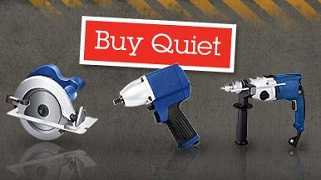BUY QUIET

NIOSH Buy Quiet Efforts
NIOSH has led efforts to promote Buy Quiet, such as developing a NIOSH Power Tools Database to make noise data available to tool buyers, users, and manufacturers of powered hand tools. The power tools database was a feasibility project to gather noise level data and make that information easily available to tool purchasers. This effort is cited both nationally and internationally as a necessary information resource for implementation of Buy Quiet programs associated with the use of powered hand tools. The power tools database can be used as a model for building a more comprehensive database of equipment and machinery noise levels and making the information readily available to the public. The most comprehensive database of noise levels available today resides with Europe & Machinery Directorate.
The NIOSH Buy Quiet Workshop held in 2011 was a The National Occupational Research Agenda (NORA) activity jointly organized by the NORA Construction Sector and Manufacturing Sector Program Programs, and the NIOSH Hearing Loss Prevention Cross-Sector Program. The purpose of the workshop was to look at whether Buy Quiet programs are feasible, how they might function, and to explore steps to ensure success at program implementation. A workshop goal was to promote the wider adoption of current and future engineering controls for noise on machinery and equipment and to motivate the Construction and Manufacturing industries to develop and begin Buy Quiet programs. Additionally in 2016, NIOSH researchers published an overview of the Buy Quiet program in Acoustics Australia entitled "Buy Quiet Initiative in the USA" which can be found here.
Join us to help promote Buy Quiet by raising awareness among workers and employers. Be part of a nationwide effort to reduce noise-induced hearing loss. Read about it on the NIOSH Science Blog or contact the NIOSH Division of Applied Research and Technology, Engineering and Physical Hazards Branch, Hearing Loss Prevention Team at 513-841-4221 to learn more.
- Page last reviewed: March 27, 2014
- Page last updated: December 2, 2016
- Content source:
- National Institute for Occupational Safety and Health Division of Applied Research and Technology (DART)



 ShareCompartir
ShareCompartir